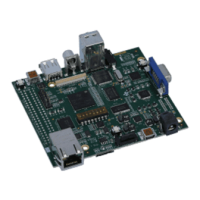Synchronous Serial Interface (SSI)
ui32SSIClk is the rate of the clock supplied to the SSI module.
ui32Protocol specifies the data transfer protocol.
ui32Mode specifies the mode of operation.
ui32BitRate specifies the clock rate.
ui32DataWidth specifies number of bits transferred per frame.
Description:
This function configures the synchronous serial interface. It sets the SSI protocol, mode of
operation, bit rate, and data width.
The ui32Protocol parameter defines the data frame format. The ui32Protocol parameter
can be one of the following values: SSI_FRF_MOTO_MODE_0, SSI_FRF_MOTO_MODE_1,
SSI_FRF_MOTO_MODE_2, SSI_FRF_MOTO_MODE_3, SSI_FRF_TI, or SSI_FRF_NMW.
The Motorola frame formats imply the following polarity and phase configurations:
Polarity Phase Mode
0 0 SSI_FRF_MOTO_MODE_0
0 1 SSI_FRF_MOTO_MODE_1
1 0 SSI_FRF_MOTO_MODE_2
1 1 SSI_FRF_MOTO_MODE_3
The ui32Mode parameter defines the operating mode of the SSI module. The SSI mod-
ule can operate as a master or slave; if a slave, the SSI can be configured to disable out-
put on its serial output line. The ui32Mode parameter can be one of the following values:
SSI_MODE_MASTER, SSI_MODE_SLAVE, or SSI_MODE_SLAVE_OD.
The ui32BitRate parameter defines the bit rate for the SSI. This bit rate must satisfy the follow-
ing clock ratio criteria:
FSSI >= 2 ∗ bit rate (master mode)
FSSI >= 12 ∗ bit rate (slave modes)
where FSSI is the frequency of the clock supplied to the SSI module.
The ui32DataWidth parameter defines the width of the data transfers, and can be a value
between 4 and 16, inclusive.
The peripheral clock is the same as the processor clock. This is the value returned by
ROM_SysCtlClockGet(), or it can be explicitly hard-coded if it is constant and known (to save
the code/execution overhead of a call to ROM_SysCtlClockGet()).
Returns:
None.
17.2.1.5 ROM_SSIDataGet
Gets a data element from the SSI receive FIFO.
Prototype:
void
ROM_SSIDataGet(uint32_t ui32Base,
uint32_t
*
pui32Data)
188 April 8, 2013

